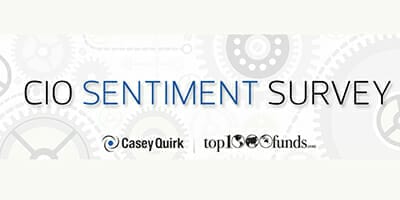Investor allocations to alternatives will increase over the next three years as the focus on outcome-oriented investments heightens, according to respondents in the annual conexust1f.flywheelstaging.com /Casey Quirk Global Fiduciary CIO sentiment survey.
The second annual survey, which included respondents from 56 asset owners with combined assets of $3 trillion, showed an accelerating trend to moving to outcome-oriented approach, as funds focused on meeting objectives.
For different respondents these objectives were different – for corporate funds it was meeting liabilities, for charities it is beating inflation and cash needs, for sovereign wealth funds growth and capital preservation and for public funds it is funding gaps leading to increased risk tolerance for growth-oriented funds and alternatives allocations
But Jeff Levi, director at Casey, Quirk and Associates, says constructing portfolios around these outcomes are more complex with alternatives allowing better management of risk exposures and low correlation.
“They are a valuable tool in executing these objectives,” he says.
Overall the survey showed the projected asset allocation changes in the next three years will see an aggregate average increase of 3.2 per cent to real assets, real estate and infrastructure, 1.8 per cent increase in illiquid alternatives (non-real assets), and 1.6 per cent increase in hedge funds. The losers will be fixed income and domestic equity.
Levi says there is increased demand for an unconstrained approach to investments in the “traditional boxes” not just within alternatives allocations.
“What have been boxed as hedge funds in the past is less relevant, they are a structure not an allocation. In the past long only allocations were style box driven, for example large cap value, and hedge funds were outside that style box. Now there is increased demand for unconstrained in the traditional boxes,” he says.
“They are re-thinking the portfolio around the risk factors, opposed to building around broad categories of type. The old way of thinking about objectives proved to be ineffective.”
As an example of the change taking place, Levi says managing fixed income against Barclays Aggregate Index is inappropriate as it has “nothing to do with the return streams the investors are looking to achieve”. As a result investors are looking more absolute return and floating rate benchmarks. Unconstrained fixed income is a hot topic.
Another clear trend is that investors plan to continue to aggressively invest in their internal investment headcount.
Investors were asked to comment on their plans for the three-year period from 2013 to 2016, and 37 per cent of respondents said they will increase their head count in finance, accounting and reporting, followed by manager research (26 per cent said they would increase), in-house portfolio management team (34 per cent), asset and strategy allocation (34 per cent), risk management (28 per cent) and technology (28 per cent).
Within manager research emphasis was being put on increasing in house expertise on alternatives as funds forgo fund of funds and gain comfort in investing directly.
Cost remained the main reason for insourcing, 40 per cent of respondents said they had plans to insource more non-cash assets, with 53 per cent citing cost as the main reason.
The average cost of internal resources of the respondents was 7.1 basis points, compared with 46.3 basis points externally. This means it is about six and a half times more expensive to outsource.
All asset classes were being considered as potential in-source management, but domestic equities were the most likely, followed by illiquid alternatives and non-domestic equity.

For investment managers, and consultants, the results show some clear changes that need to take place in servicing these institutions, in particular segmentation becomes critical as there is no one -size fits all for the investor community.
“Buyers with in-house teams want different skills and investments and engagement model,” says Levi. “This also has implications for staffing. Fund managers need people who are consultative and have know-how to have a conversation with the CIO. You need those who are investment savvy, those with the tools to conduct analysis and have a customised views. And you need to wrap all of it in a strong investment brand, have innovative insights and thought leadership with a marketing presence. It is about flexibility, a conversation with one buyer is very different from another.”
In addition funds managers will be competing with the buy-side, as institutional investors look to their peer group for ideas and information exchange, rather than traditionally looking to the funds management community.
Similarly the investment consulting fraternity is undergoing a change, as institutional investors bring more manager research capabilities inhouse.
For the period 2008-2012, 31 per cent of respondents increased headcount in manager research, for 2013-2016, 36 per cent are increasing headcount in due diligence and selecting managers.
“In the UK and in US public plans it is mandated to have a consultant, but there are questions about the role of consultants and how they are used if the internal team size is increasing,” Levi says.
This re-adjustment of the consultants role is amplified by the fact managers are playing a larger role in unconstrained mandates and giving advice.
Change is afoot for all participants in the institutional investment chain.



